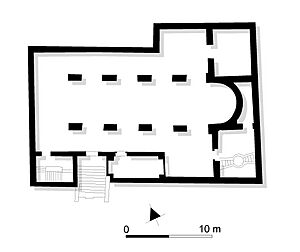Second battle of Dongola facts for kids
Quick facts for kids Second battle of Dongola |
|||||||
|---|---|---|---|---|---|---|---|
| Part of the early Muslim conquests | |||||||
|
|||||||
| Belligerents | |||||||
| Rashidun Caliphate | Makuria | ||||||
| Commanders and leaders | |||||||
| Abdallah ibn Sa'd | Qalidurut | ||||||
| Strength | |||||||
| 5,000 men including cavalry and 1 catapult | Considerable number of archers on city walls | ||||||
| Casualties and losses | |||||||
| Unknown | Unknown | ||||||
The Second Battle of Dongola was an important fight in 652 between early Arab forces and the Christian kingdom of Makuria in Nubia. This battle stopped the Arab expansion into Nubia. It also led to a long-lasting peace and trade agreement between the Muslim world and a Christian nation. Because of this, Makuria became a strong power in Nubia for over 500 years.
Why the Battle Happened
The relationship between the kingdom of Makuria and the Arab leaders in Egypt started roughly. They had a first battle in 642. After that fight, the Arabs left Nubia, and things were peaceful for a few years.
However, a historian named al-Maqrizi said that Makuria broke the peace agreement. So, Abdallah ibn Sa'd, the new Arab governor of Egypt, decided to invade Makuria. He wanted to make the Makurians follow the rules. At this time, King Qalidurut ruled all of northern and central Nubia.
Archaeological finds show that Dongola was a very strong city in the 600s. Its walls were about 6 meters (20 feet) high and 4 meters (13 feet) wide at the bottom. They were made of mudbricks and covered with stone. The city also had strong towers. These towers might have been built after the attack in 652 to make the city even safer.
The Battle of Dongola
Abdallah led an army of 5,000 soldiers to Dongola, the capital of Makuria, in 651. His army had strong horse riders (heavy cavalry) and a catapult. A catapult is a large machine used to throw big stones. According to al-Maqrizi, the Makurians had never seen a catapult before.
Abdallah's army then surrounded the city. This was a risky move for his horse riders because the city was well-protected. The Nubian archers, famous for their skill, defended the walls. During the attack, the city's main church was hit and damaged by stones from the catapult.
The fight ended in a big battle. Abdallah's army suffered many losses. King Qalidurut did not give up or ask for peace. In the end, Abdallah stopped the attack and agreed to a peace deal called a baqt.
A historian named Ibn 'Abd al-Hakam wrote that Abdallah stopped the siege because "he was unable to defeat them." Another historian, Ahmad al-Kufi, wrote that "The Muslims had never [before] suffered a loss like the one they had in Nubia." An Arab poet described the battle, saying his eyes had never seen a fight like the one at Dongola.
Later, some Muslim historians changed the story. They said the battle was a victory for the Arabs. They claimed King Qalidurut came out of the city asking for peace. This different story might have mixed up the events of 652 with later fights between Nubia and the Mamluks in the late 1200s.
What Happened After
The details of the Second Battle of Dongola are not fully known. But we do know that the Arab army lost so many soldiers that they could not capture Dongola. Both sides agreed to a peace treaty called the Baqt. This agreement lasted for 600 years.
The baqt set up trade between Muslim Egypt and Christian Nubia. Egypt traded wheat, barley, wine, horses, and linen. In return, Nubia sent 360 slaves to Egypt each year.
This peace treaty was very unusual for its time in early Islamic history. Nubia was also special because it was a Christian region that was not conquered. Its rulers dealt with Muslim rulers as equals for a long time. This lasted until the 1100s, when Nubia's power started to fade. Because of this battle and the baqt, Christian Nubia was able to grow and thrive for the next six centuries.


